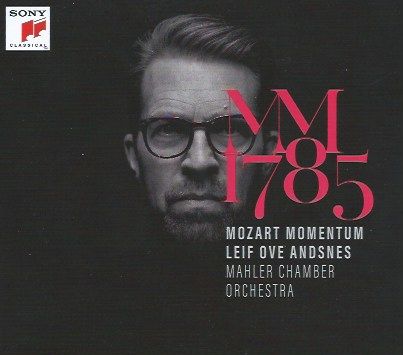Mozart Momentum 1785: Leif-Ove Andsnes

The inventive, imaginative Norwegian pianist Leif-Ove Andsnes never fails to stimulate. Here is his latest offering, and it's an absolute gem! Mozart Momentum 1785 concentrates on works from the seminal period of 1785 (and 1786) - a time when Mozart was freelance in Vienna. He had arrived in the Austrian capital in 1781 - to stay, as it turned out, gievn that the Archbishop in Salzburg dismissed him. By 1785 he was financially secure (for the first time) and able to expand the depth of his work to unprecedented levels. This is the "momementum" of the title of this twofer. As Andsnes says:
When you realize how quickly Mozart developed during the early years of the 1780s it makes you ask: why did this happen? What was going on? It’s about the momentum of his creativity at this time
But let's let Andsnes himself have a word or two (the ntroductory video is only one miinute long):
Disc one contains two concertos from this period, Nos. 20 and 21. One aspect that is immediately noteworthy is Andsnes's imagination with the cadenzas he chooses: Beethoven is the expected choice for the first movement of No. 20 (a terrific cadenza), then Hummel's in the finale; for No. 21, it's Géza Anda's for the first movement and Dinu Lipatti's for the finale.
What marks out this set is how Andsnes and his players nail the harmonic feel of each piece. The first movement of the DMinor Concerto (No. 20) takes in all of that darkness, but also allows for grace. It really shows the daring writing Mozart allowed himself to open out to at this time of his creative life:
Andsnes does decorate the line in the slow movement - and very tastefully as well, while teh Mahler Chamber Orchestra project all of the fire of the finale.
The Piano Concerto No. 21 in C, K 467, while taking us into the major mode, echoes the sophistication fo its neighbour. Hearing it in context like this is instructive - we hear its structural integrity, and how the bright glow and pomp of C-Major contrasts likenight and day with the D-Minor of K 466. The performance is just as fine, too, with the rhythmic discipline highly impressive:
This a lovely performance, the finale scampering but not rushed in any way, the piano's opening trills beautifully annunicatory of the instrument's presence, the orchestra blazing with C-Major light:
To start off the second disc, the magnificent Fantasia in C minor, K 475, is given a performance of depth and profundity; listen to the bleakness Andsnes finds in the C minor chords towards the end, or the foreboding yoked with mystery at the opening:
... the minor mode is continued in the astonishing G-Minor Piano Quartet, in which Andsnes is joined by Matthew Truscott, violin, Joel Hunter, viola and Frank Michael Guthmann, cello. Listen to the drive of the G-Minor and Mozart's way with light and shade - and how the players react to each harmonic and timbral shift with true sensitivity:
How eloquent is the Andante here (a true Andante - it moves!), and how dark the clouds that glower at times over it. This is a magnificent performance of a gem of chamber music, the rondo finale unhurried (the performers carefully noting the "moderato" of the Allegro moderato instruction). And how fitting to have the Masonic Funeral Music after it (Mauerische Trauermusik: Mozart was famously a Freemason). This is one of his darkest pieces, and most poignant ones. The Mahler Chamber Orchestra is on positively electric form:
The set ends with one of Mozart's most glowing works, the E flat Concerto, K 481 (No. 22). It's not heard as often as those surrounding it which is a shame: unashamedly symphonic in conception, and the sense here is of soloist and orchestra communicating as of one mind. While for many years my preferred performacne of this was via a Decca LP of Ashkenazy directing the Philharmmia (the LP coupled the Concerto with a Mozart Concert Rondo, K 382), I'm happy to let Andsnes and the Mahler CO take over top slot:
It's remarkable how one can hear how the use of clarinets in the tuttis of this piece colours the sound; and how the winds shine in the central Andante (with that bubbling chalumeau-register clarinet!):
Andsnes and the Mahler Chamber Orchestra are full of vim and vigour in the bracing finale, the perfect close to a magnificently planned set bursting at teh seams with fine performances. For me, it's the account of Piano Concerto No. 22 thet seals the deal - wholesome, knowing, wise ...
I've included a link below not only to the product itself on Amazon, but also to a free digital copy of the booklet (the second link).
